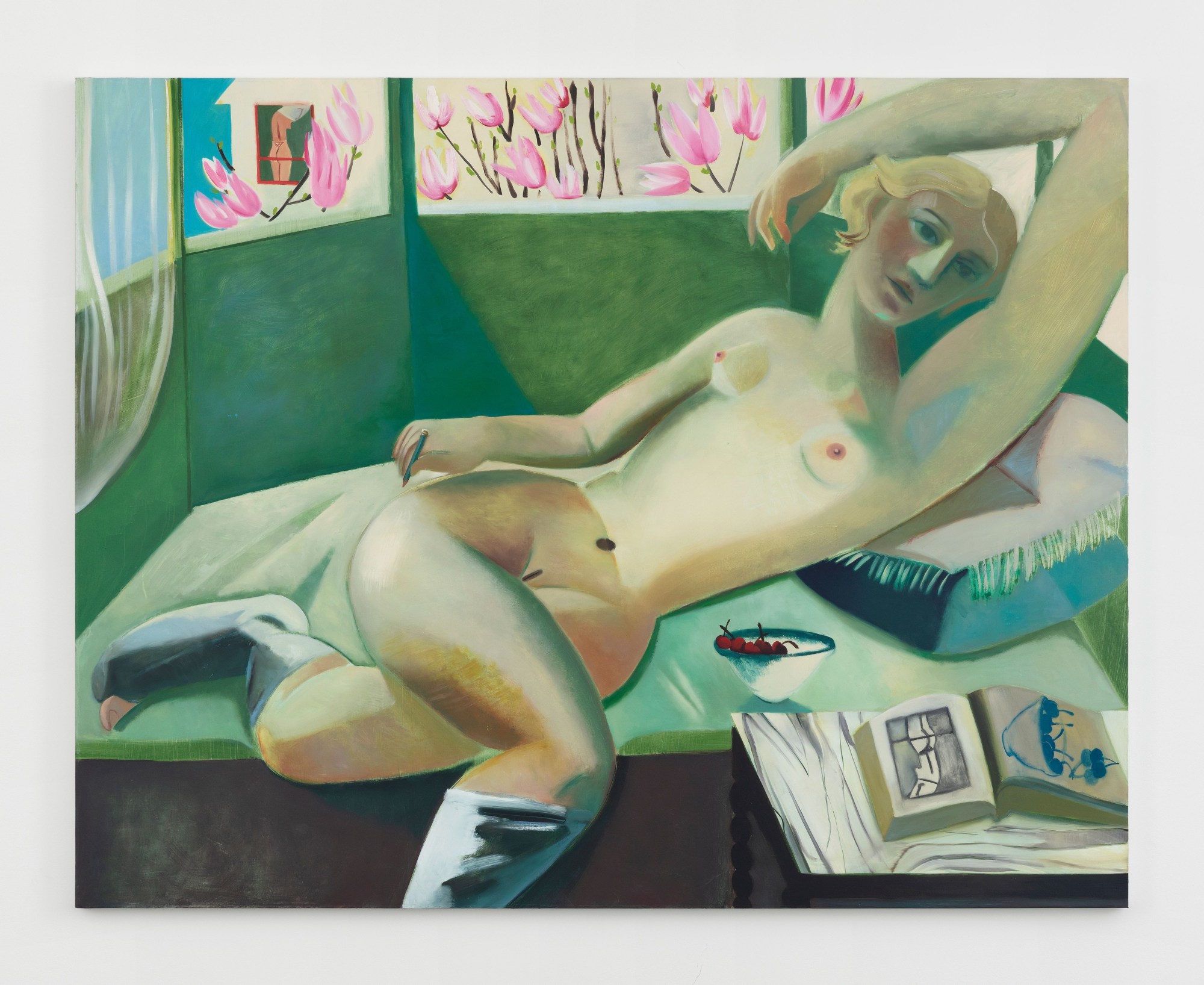Danielle Orchard portrays the embodied reality of the female form articulated in a vivid color palette. Her canvases are subtly threaded with art historical decoys — nods to Ernst Ludwig Kirchner, Henri Matisse, Georges de La Tour, Balthus — but always revamped in ways that speak to contemporary questions of selfhood and gender expectations. Her work confronts the female experience in all its angst and absurdity, emphasizing the way the body falls short of what we wish it to be. “Lint”, for example —which recently graced the cover of The Paris Review — is carefully cropped to frame a lower waist and genitalia girded by sheer pantyhose, calling attention to the way women are expected to quite literally reshape their silhouettes at the expense of their own comfort.
Amidst her work at Galerie Perrotin in Paris, where her solo show Page Turner was on view this month, we spoke to Danielle about her devotion to museum-going, wrestling with insecurities, and the perils of basket crotch.
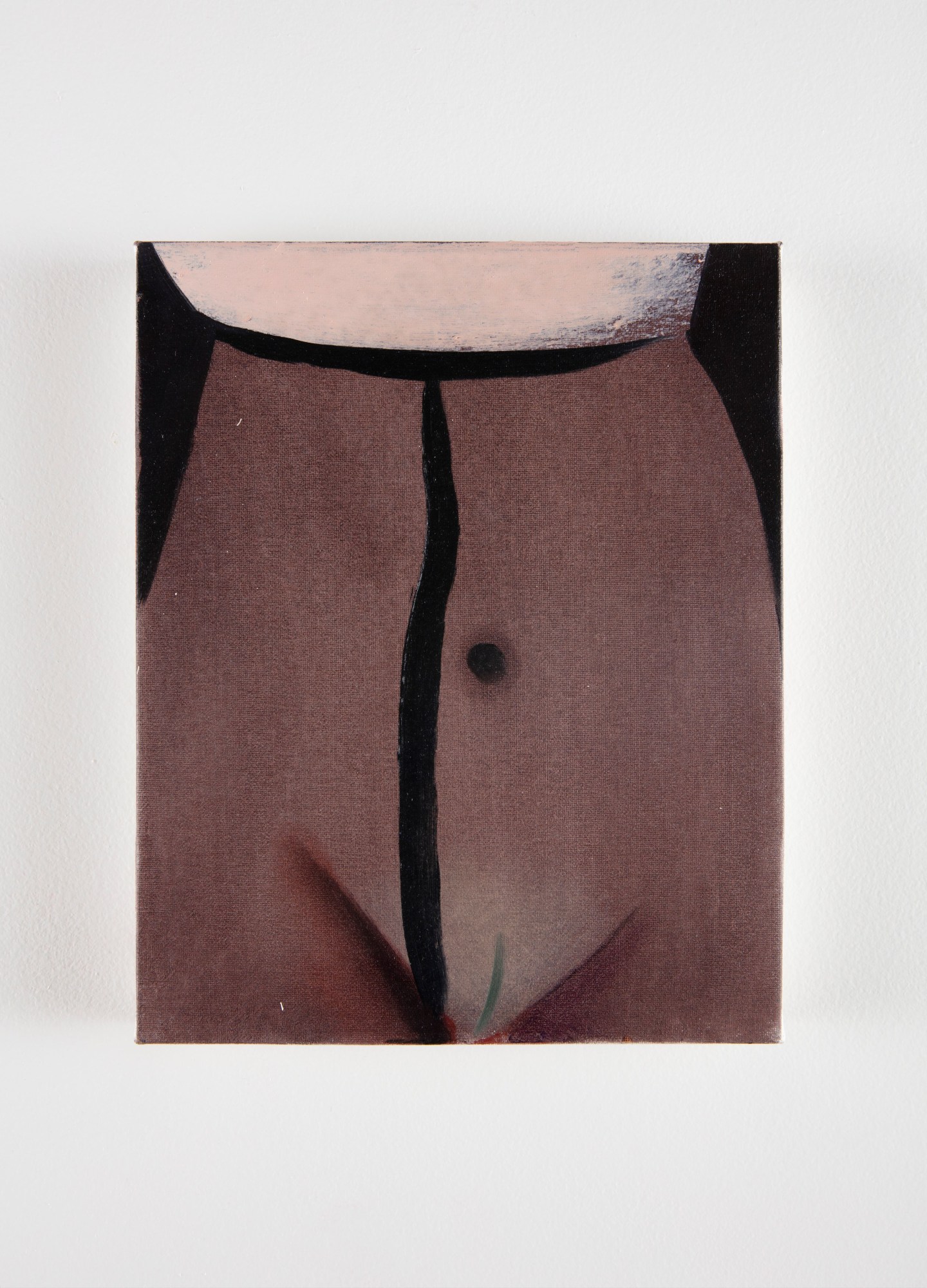
There are recurrent visual echoes throughout your work, forms of mirroring or twinning… Can you talk about setting these up?
There’s a lot of layering of levels of reality within the image. Like, is their world referring to ours? That opens up doors to play with scale. I love the hierarchy of scale you see throughout art history: paintings where the God — or whoever is the most salient figure — is the biggest, and the least important is the tiniest. So I’ve been messing around with that. These games lend themselves to a kind of mysterious narrative read, which aren’t always completely articulated. They’re mysterious to me as well!
Further feeding this mystery, the works seem to have this… placelessness that makes them feel disconcerting.
They’re not typically related to an exact environment. It’s more calling to mind a certain scene that is kind of an amalgamation from different art historical references.
How do you select those references?
For “Page Turner,” it started as a departure from [Diego] Velázquez’s “The Toilet of Venus” that I saw in the National Gallery in London. There’s a mirror being held up by Eros, and Venus is nude and looking in the mirror, but her eyes are closed. It’s such a mysterious but potent image. A mirror is typically a condemnation of vanity, or at least pointing to vanity in some way, and yet her eyes are closed. This is a masturbation scene, but there’s this kind of mind/body separation. It’s a common thing in mindfulness practices: striving for unity between mind and body. It’s funny that it’s such a common part of our parlance now, particularly for women. Seeking wellness is actually a source of anxiety. So it’s kind of like: well, what is her relationship to her own image in that painting?
From there, I ended up accidentally blending it with an odalisque and that departure from realistic anatomy. A distortion of the female body. So much can play out in that exercise.
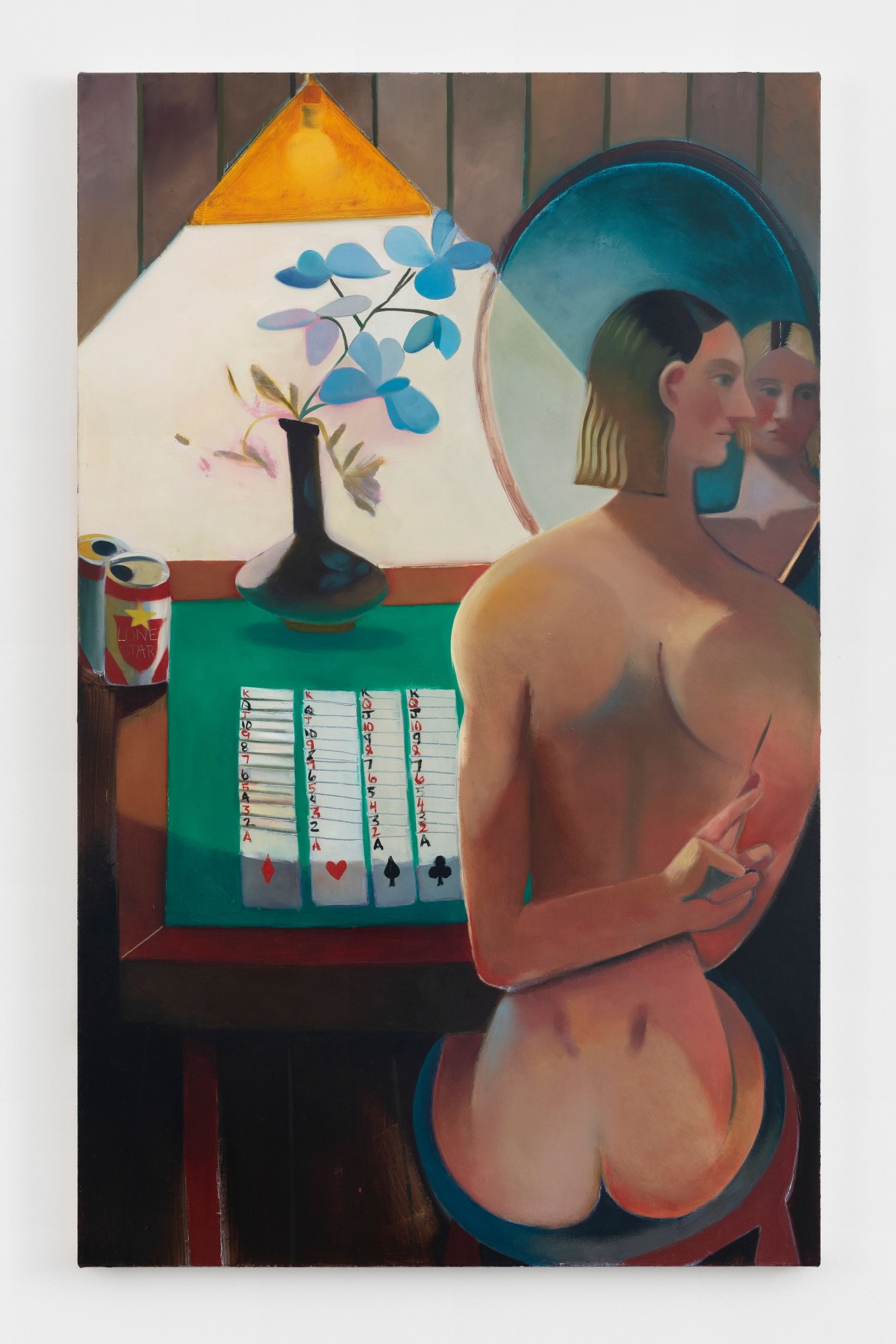
Speaking of which: can you talk about Lint, your painting spotlighting the tops of pantyhose? They’re framed like a modern corset here.
My initial interest in them stemmed from girlhood… I had long legs as a kid, pantyhose and tights just always had this kind of, like, basket crotch thing. It’s such a visceral experience wearing those — if you’ve ever put them on, you know exactly what it feels like. It’s not a particularly sexy garment, I don’t think. The containment of the body — it’s quite uncomfortable. I’m very interested in the symbol of the thing, the experience of the thing, and the conveyance of that thing: How all that operates together.
In terms of this idea of how people are perceived, can you talk about “Rear Windows”?
It starts with just the geometric shape: a bay window. I thought it would be a nice way to contain the full form of the woman. From there, I started thinking about viewership and how unaware — especially in New York —people seem to be of how much you can see directly into their homes. And they take no precautions. Or they don’t care. Or they’re actually encouraging it. Impossible to say. But, at all times, in close quarters, you get a sense of other people’s very private lives.
Voyeurism is a reality of living there.
[Laughs] It’s kind of forced on you. Which is an interesting thing to explore in painting: forcing the viewer into this position of voyeurism. I think that the way voyeurism has been used throughout art history, it’s like the viewer is taking advantage of a hapless subject. But in this painting, I think she’s very much indifferent to being viewed; she’s sort of doing the same thing to the woman behind her, and you can imagine it goes back even further into the space, into other levels of voyeurism.
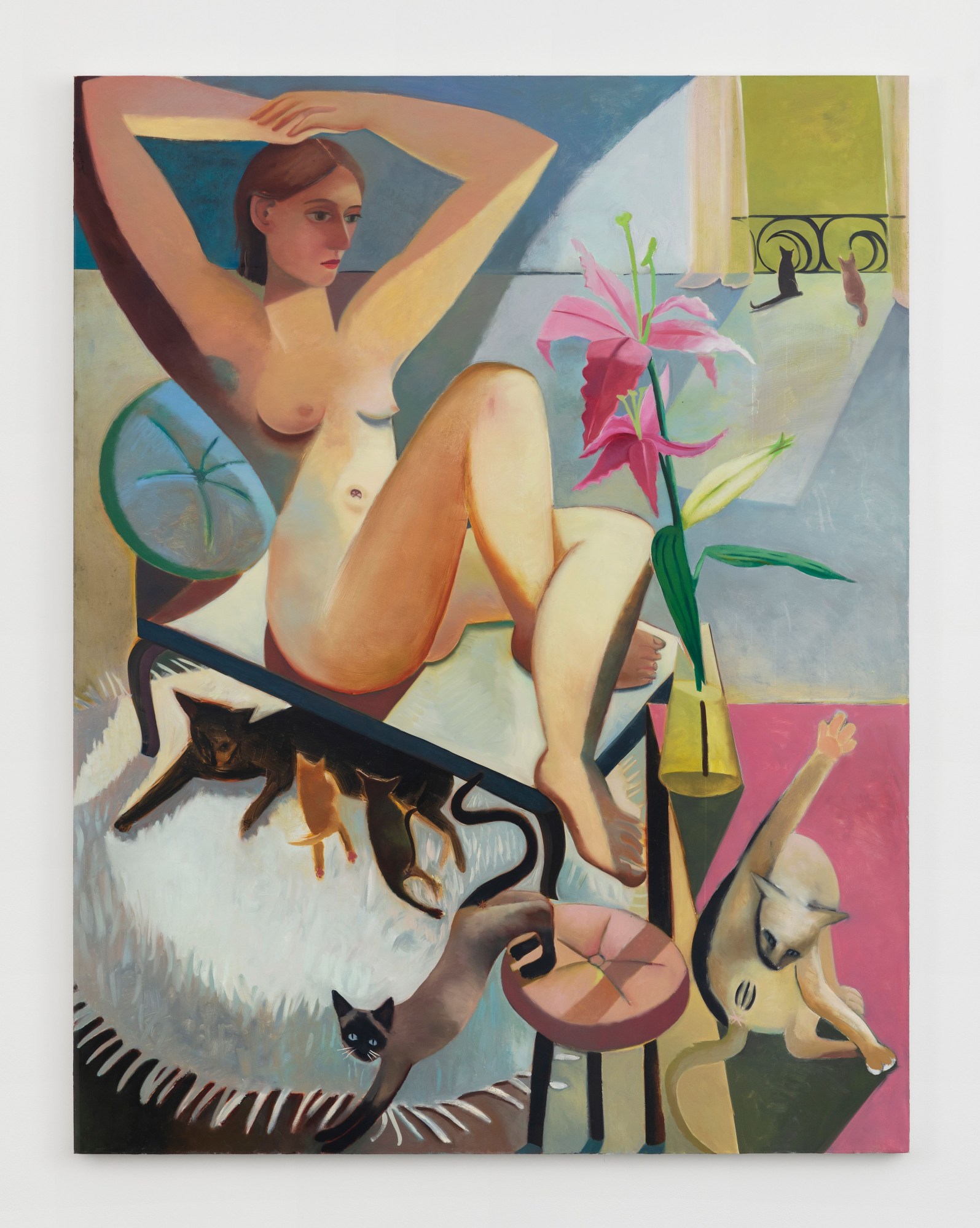
I love the toe poking out of the sock — that’s a great detail.
It’s like… wardrobe failures. Every time you go to a party and forget that they’re gonna make you take your shoes off, and you wore your worst socks…
I am only ever wearing my worst socks in that scenario.
I have a little cache of party socks.
That’s wise!
I’ve been embarrassed so many times.
This sense of tongue-in-cheek in your work is so present — how is humor part of the thinking behind the paintings?
There’s so much drama in studio life, especially as a painter without any assistants or a lot of voices in the studio. My studio is in Ridgewood. I always say Bushwick because it feels a little bit more like Brooklyn — in a small building. There are two sculptors and a painter and myself. Everyone’s very serious and quiet. It’s a solitary existence, which means that every single one of your thoughts and insecurities are amplified that much more, because you’re not bouncing them off of anyone. Not to say that I don’t have a lot of conversations with other artists, but the nine-to-five is very insular and you’re in your head a lot. It’s not that I think that painting is incredibly important — it’s not an emergency, you know? — but it tends to feel that way. I guess the idea of failure, and the humor attached to it, is something that is operative in making a painting. Failures are just so intrinsic to the practice. You have to make so many bad paintings to ever hope to get good at painting. Or you have to accidentally ruin so many good paintings, and that also ultimately makes you better.
What is a “bad painting”? Is there a process of revision, or actual casting aside and starting afresh?
It depends… it tends to be more a process of revision, but I’ve certainly had to scrap some, like, absolute hopeless cases. It’s quite freeing to do that as well. That sort of destructive impulse is, I think, very much a part of art making. But yeah, revision is also building up surface. It takes forever and it looks terrible while you’re doing it, and then all of a sudden…
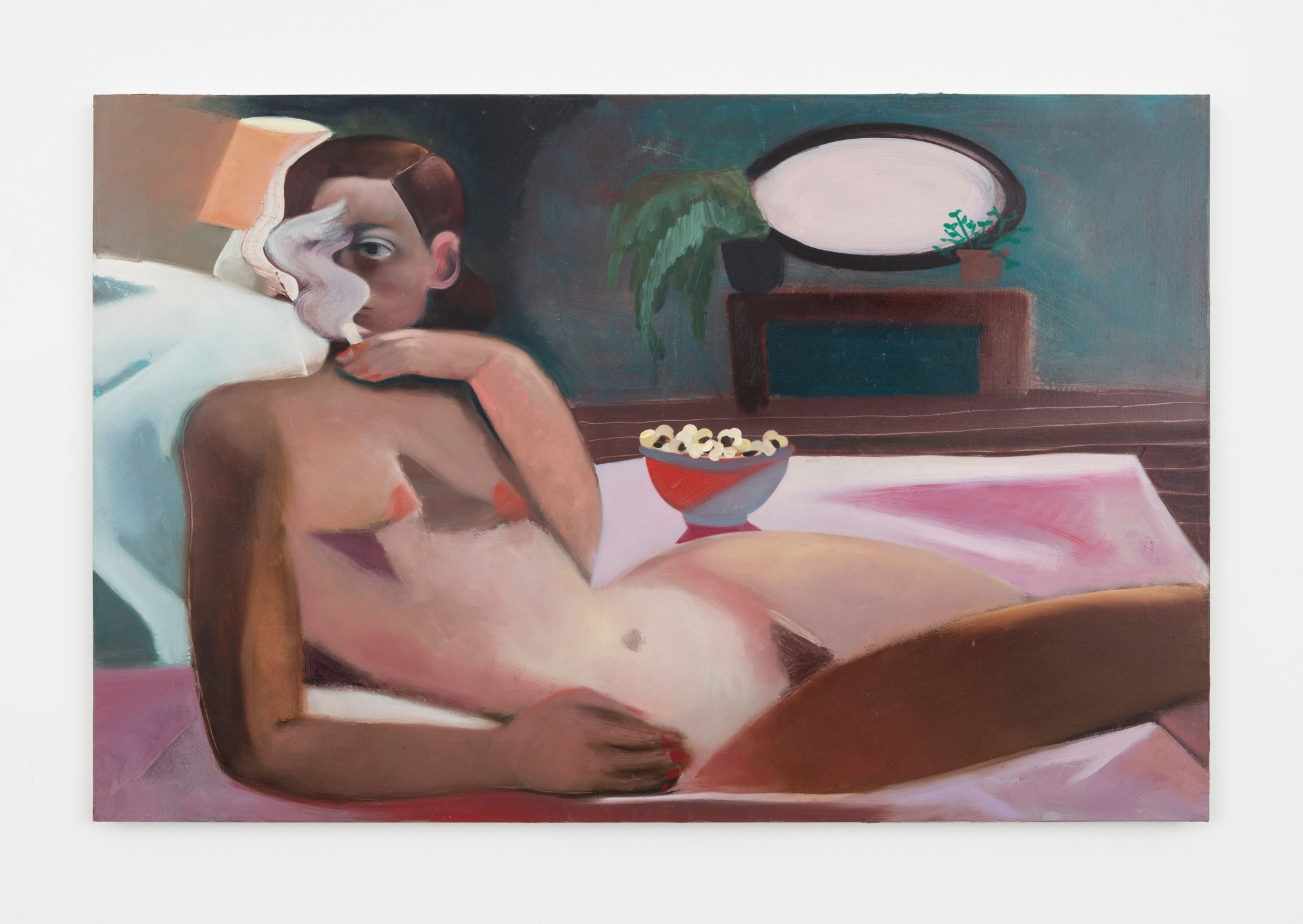
The “aha!”
Yes. But underneath it is so much frustration.
…That is relatable.
And the type of color exploration that I’m interested in very much has to be played out on the canvas. It’s not premeditated: I like to work very intuitively with color, and so that means that you put something down and it just doesn’t work. Then there’s this drying time when you’re working with oil paint in particular. So you put something down in hopes that it will work; you sit with it, put it aside, and that allows you extra space and time to look at the thing. It really forces slowing down.
Do the reactions you get to paintings differ across the gender spectrum? Is it mostly women who respond to them, because their experiences are featured?
There’s a few narrative moments that are lost on people who haven’t worn some garments. I have a painting based on one by [Ernst Ludwig] Kirchner featuring a woman looking into a mirror, and her reflection doesn’t align with her body. I thought that was so psychologically charged—especially for a man to have painted that. I did a version of it: In mine, it’s really about trying to adjust your bra while you’re wearing it, and that kind of, like, tangle of feeling so many different parts of your body at once, and like trying to get comfortable—but also make it look good. And that gesture seemed to be lost on anyone who has not worn a bra. Anyone who had immediately understood what it was about. Like the danger of shaving: if you don’t do that regularly on tender skin, then you don’t know how much it sucks when you’re trying to run out the door and bleeding on the carpet. Men buy my paintings—but I’m not sure for what reason, you know? Maybe they’re responding more to color, or the formal nature of the work.
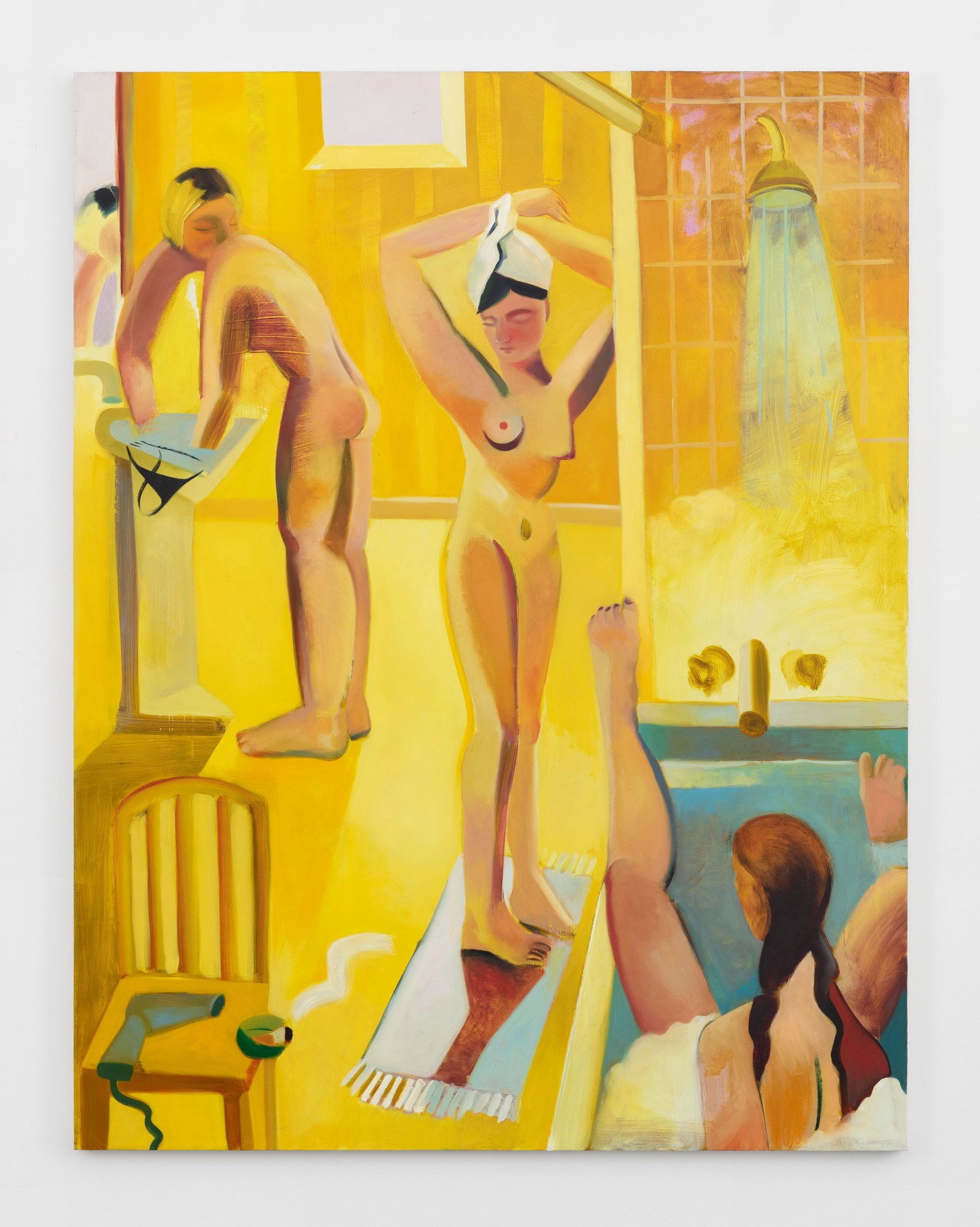
As someone drawing so recurrently from art historical references, are there certain museums you frequent? Or any rituals for taking in art history references?
Oh, sure. I mean, New York is unending. I love all the heavy hitters for sure. I love that you can take out works on paper from the Morgan Library. It’s an active research library. All you have to do is request anything from their archives. And they have just everything you can imagine. They have all these fantastic artists, and they put them in front of you, and then just leave you alone. And then they let you into the museum afterward! It strikes me as the enormous privilege of living in New York.
I went to London last year. It was the first time I’d left New York since the pandemic. I went to every museum twice. It’s all I ever want to do when I’m traveling. I have a few artists friends in town for the show, and we went to the Musée Cluny, the medieval museum. I love slightly smaller museums with strange objects. The Louvre was packed; it was impossible to see anything. But I go to everything I can in New York. Commercial galleries, which are rotating much more quickly… If I’m going to hang out with a friend, it’s usually structured around viewings, just like a Chelsea tour for the afternoon. So yeah, pretty much constantly. If I’m stuck in the studio, I make a point to do that, because I can feel a sort of… shutting down.
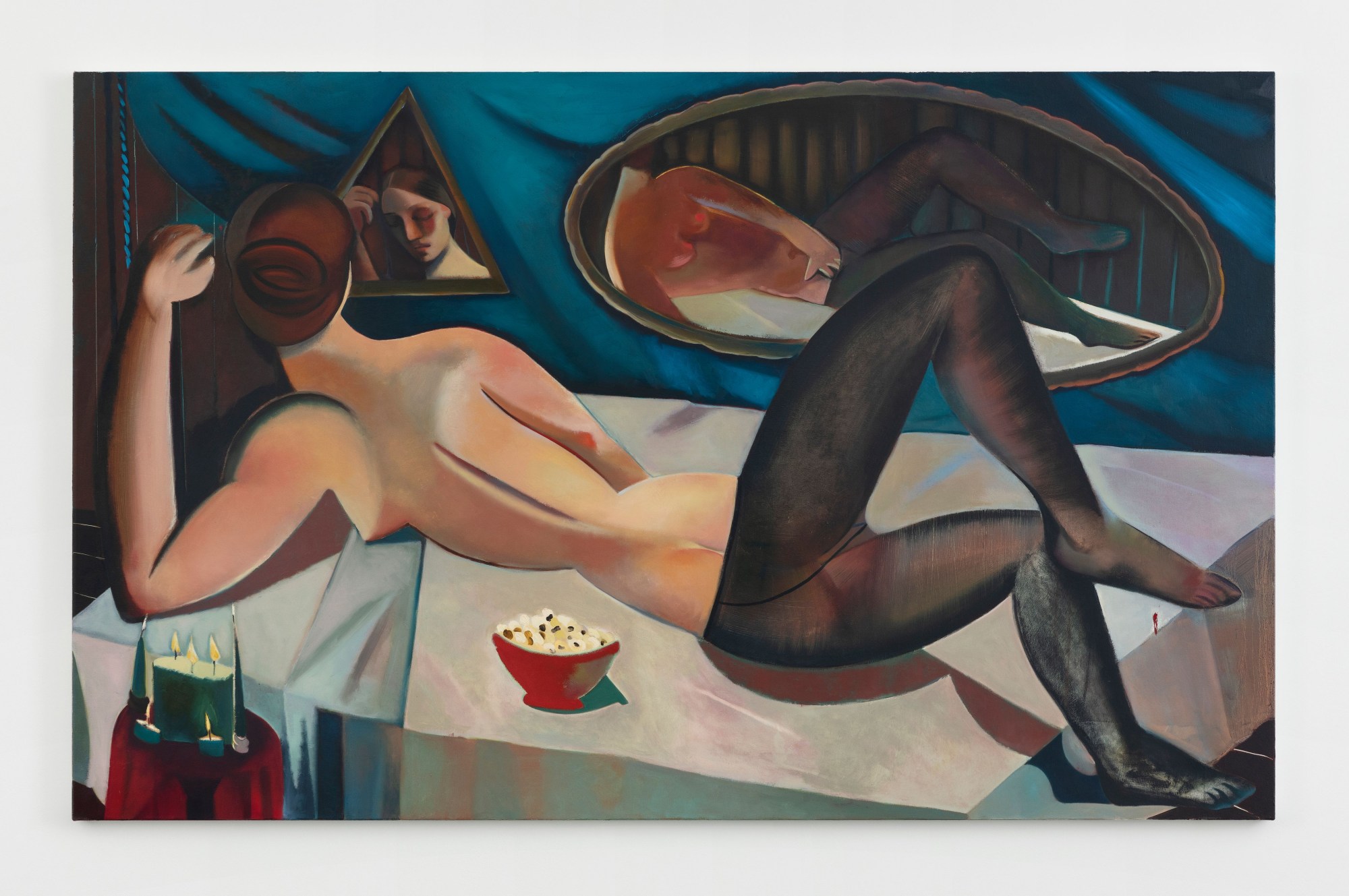
You need to regenerate by seeing other things.
Yeah, totally: you go out, and it just resets you. Like: writers read so much more than they write. It’s true of painting too. Viewing is very, very important. You can really tell when an artist is doing enough or not enough. People can make things that exist outside of the art historical conversation entirely and create their own worlds, and that’s also fascinating. But I’m very interested in continuing that conversation.
Can you talk about Lessons?
I was thinking about Balthus’ [1938 painting] Thérèse Dreaming: it’s at the Met, I’ve seen it a million times. I just always loved his work. It’s sinister and quiet and really structured and the geometry really appealed to me. I didn’t realize until much later all the controversy around that work. It just makes it even richer to know how it’s been received through time.
I became interested in what could have happened to that subject in adulthood. It’s a very obvious erotic image. But I thought it would be funny to have her, like, grow up into a cat lady. Like, this other female trope: a spinster with too many cats. And, you know, just like a reason to paint cats and explore their weird forms and the humor that’s intrinsic to those animals.

A lot of these paintings are of individuals who have this sense of mysterious interiority. What changes when you paint group dynamics?They’re potentially the same character, but in a different position and time. Sometimes they operate that way. I just started compositionally, and I won’t have a sense of their relationship to one another, or if they’re even inhabiting the same moment in time. But I also think that when I intentionally make them inhabiting the same amount of time, they seem to be unaware of one another. It underscores the fact that they aren’t engaged.
Same space does not mean that they’re actually together.
At my last exhibition, at Perrotin in Seoul, there was a painting of a group of women at a dining room table and there’s a birthday cake in the center—but it’s completely joyless. I really wanted them to feel as if they were in the same room at the same moment, but actively disengaged. But other times, it’s more mysterious and I’m not even sure! There’s a lot of unanswered open-endedness to the images.
Your painting, Shaving, references an early scene from Psycho. There is something cinematic-feeling about that looming quality you capture. I don’t know if Lynchian would be apt an apt parallel, but there’s that ability to evoke something jarring from something banal, even though you’re not sure why you’re alarmed.
What happens commonly is I’ll try to remember something with specificity—and that fails. But the result is kind of eerie… It wasn’t what I was seeing in my mind’s eye, but it just becomes this painted reality, and you follow that mood that’s potentially difficult to name… like the uncanny. I don’t ever think about a particular filmmaker. But when you’re pulling from memory, so much of it is memory of movies and TV—all of that really informs the way that we picture things anyway.
It creates a kind of visual image bank— it’s not explicit, but it just… loiters.
Absolutely! In the studio, you’re free of any interaction, and that makes you feel like your boundaries cease to exist between what you’re making and what you’re imagining. So many different factors contribute to your mental picture of a thing. Identity is very similar: the way that you present is so different from what you think is going on. Which can be upsetting. But it’s also just a part of being alive.
